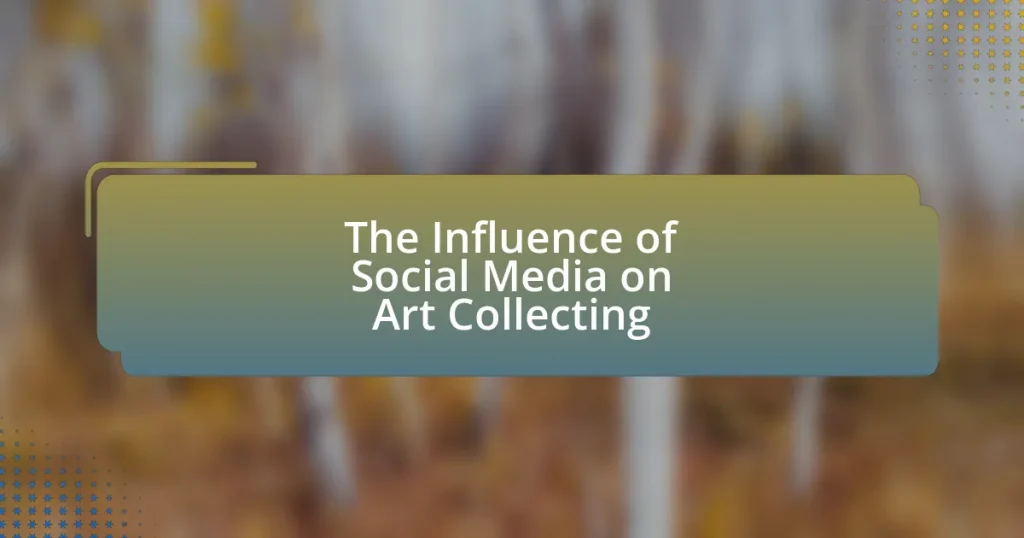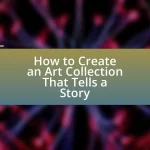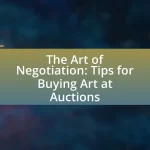The article examines the significant influence of social media on art collecting, highlighting how platforms like Instagram and Pinterest enhance visibility and accessibility for artists and collectors. It discusses the transformation of the art market, where 70% of art buyers under 35 utilize social media to discover new artists, leading to direct communication and relationships that foster sales. Key platforms such as Instagram and Artsy are identified as pivotal in shaping art collecting trends, while the article also addresses the challenges collectors face, including information overload and authenticity concerns. Additionally, it explores strategies for collectors to effectively engage on social media and the future trends that may further evolve the art collecting landscape.
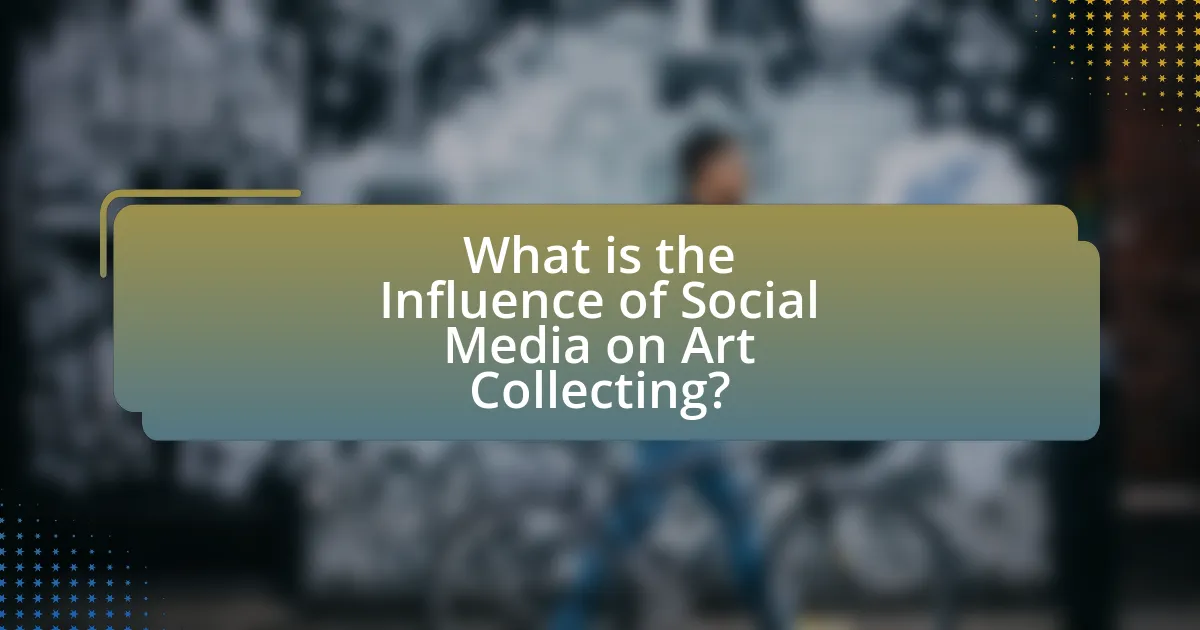
What is the Influence of Social Media on Art Collecting?
Social media significantly influences art collecting by enhancing visibility and accessibility for both artists and collectors. Platforms like Instagram and Pinterest allow artists to showcase their work to a global audience, leading to increased exposure and potential sales. According to a 2021 report by Hiscox, 70% of art buyers under 35 use social media to discover new artists, indicating a shift in how art is marketed and sold. Additionally, social media facilitates direct communication between artists and collectors, fostering relationships that can lead to sales and collaborations. This democratization of art collecting has transformed traditional practices, making it easier for emerging artists to gain recognition and for collectors to find unique pieces.
How has social media changed the landscape of art collecting?
Social media has transformed the landscape of art collecting by providing unprecedented access to artists, artworks, and collectors globally. Platforms like Instagram and Pinterest allow collectors to discover emerging artists and trends in real-time, facilitating direct engagement and transactions. According to a 2021 report by Hiscox, 63% of art buyers aged 18-34 have purchased art online, highlighting the shift towards digital platforms for art acquisition. Additionally, social media enables artists to build personal brands and connect with audiences, which has democratized the art market and expanded the diversity of voices represented. This shift has led to a more inclusive and dynamic art ecosystem, where collectors can engage with art in ways that were previously unavailable.
What platforms are most influential in art collecting?
Instagram and Artsy are the most influential platforms in art collecting. Instagram’s visual-centric format allows artists and galleries to showcase their work to a global audience, facilitating connections between collectors and creators. Artsy, on the other hand, serves as a marketplace and resource for collectors, providing access to a wide range of artworks and information about artists and galleries. According to a 2021 report by Hiscox, 63% of art buyers use social media to discover new artists, highlighting the significant role these platforms play in shaping art collecting trends.
How do social media trends affect art market values?
Social media trends significantly influence art market values by increasing visibility and accessibility for artists and artworks. Platforms like Instagram and TikTok allow artists to showcase their work to a global audience, leading to heightened demand and potentially higher prices. For instance, a study by ArtTactic in 2021 found that 70% of collectors reported that social media influenced their purchasing decisions, demonstrating a direct correlation between online presence and market value. Additionally, viral trends can create urgency and exclusivity, further driving up prices as collectors rush to acquire trending pieces.
Why is social media important for contemporary artists and collectors?
Social media is important for contemporary artists and collectors because it provides a platform for visibility, engagement, and networking. Artists can showcase their work to a global audience, facilitating direct interaction with potential buyers and art enthusiasts. For instance, platforms like Instagram have become essential for artists to share their portfolios, with over 1 billion monthly active users, allowing for significant exposure. Collectors benefit by discovering new artists and trends, as social media enables them to follow their interests and connect with other collectors and galleries. This interconnectedness fosters a vibrant art community, enhancing the overall art market.
How do artists use social media to reach potential collectors?
Artists use social media to reach potential collectors by showcasing their work, engaging with audiences, and building a personal brand. Platforms like Instagram and Facebook allow artists to post images of their artwork, share behind-the-scenes content, and interact directly with followers, which fosters a sense of community and connection. According to a 2021 survey by Artfinder, 70% of artists reported that social media significantly increased their visibility and sales opportunities. This direct engagement not only helps artists to promote their pieces but also enables them to cultivate relationships with potential buyers, making it easier for collectors to discover and purchase art.
What role does social media play in building an artist’s brand?
Social media is crucial in building an artist’s brand by providing a platform for direct engagement with audiences and showcasing their work. Artists can share their creative process, promote new projects, and connect with fans, which enhances visibility and fosters a loyal following. According to a 2021 survey by the National Endowment for the Arts, 72% of artists reported that social media significantly contributed to their ability to reach new audiences and sell their work. This direct interaction not only helps in establishing a personal brand but also allows artists to receive immediate feedback, adapt their strategies, and cultivate a community around their art.
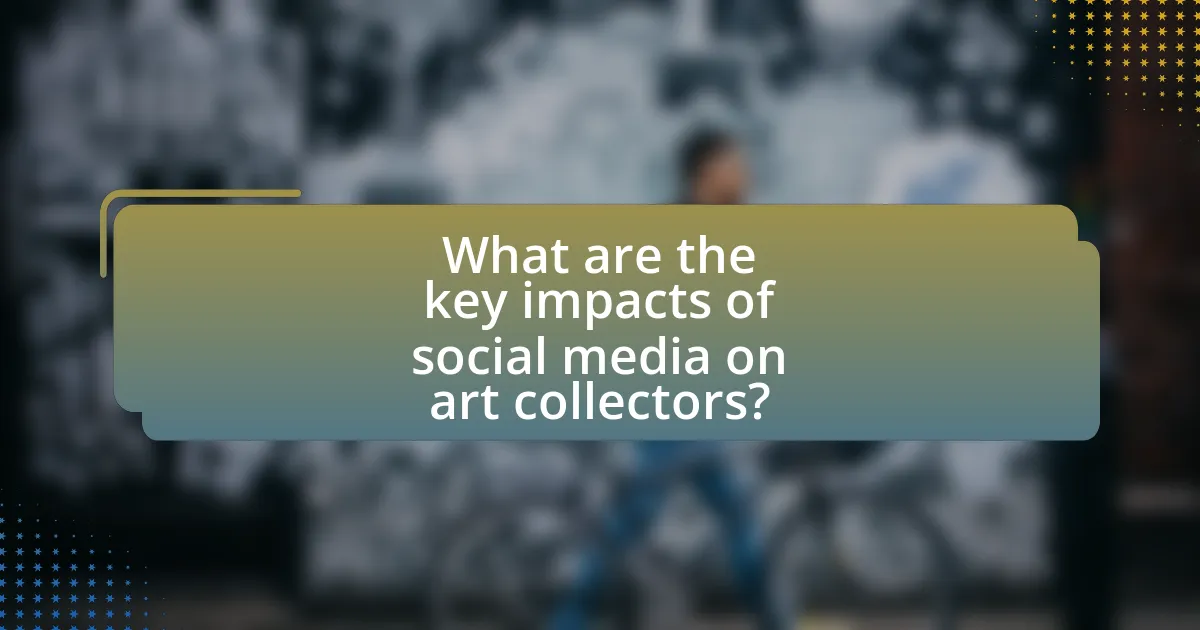
What are the key impacts of social media on art collectors?
Social media significantly impacts art collectors by enhancing access to diverse artworks and facilitating connections with artists and other collectors. This increased accessibility allows collectors to discover emerging artists and trends that may not be visible in traditional galleries. For instance, platforms like Instagram and Pinterest have become vital for showcasing art, with over 70% of art collectors using social media to find new pieces, according to a 2021 Art Basel and UBS report. Additionally, social media fosters community engagement, enabling collectors to share insights and experiences, which can influence purchasing decisions and investment strategies.
How does social media facilitate connections between collectors and artists?
Social media facilitates connections between collectors and artists by providing platforms for direct interaction and engagement. These platforms, such as Instagram and Facebook, allow artists to showcase their work to a global audience, while collectors can discover new art and connect with creators directly. According to a 2021 survey by Art Basel and UBS, 70% of collectors reported using social media to find new artists, highlighting its role in expanding networks and fostering relationships in the art community.
What are the benefits of networking through social media for collectors?
Networking through social media offers collectors enhanced access to a global community, facilitating connections with other collectors, artists, and galleries. This expanded network allows collectors to share insights, discover new trends, and gain access to exclusive opportunities, such as private sales or exhibitions. For instance, platforms like Instagram and Facebook have become vital for collectors to showcase their collections and engage with a wider audience, leading to increased visibility and potential sales. Additionally, social media enables collectors to participate in discussions and forums, fostering knowledge exchange and collaboration, which can enrich their collecting experience.
How do online communities influence art purchasing decisions?
Online communities significantly influence art purchasing decisions by shaping perceptions, providing social proof, and facilitating access to diverse artworks. These communities, often found on platforms like Instagram and Facebook, create environments where users share recommendations, reviews, and personal experiences related to art purchases. For instance, a study by the University of Southern California found that 70% of consumers are influenced by online reviews and community discussions when making purchasing decisions. Additionally, the visibility of artists and their work within these communities can enhance credibility and desirability, leading to increased sales.
What challenges do art collectors face in the age of social media?
Art collectors face several challenges in the age of social media, primarily including information overload, authenticity concerns, and market volatility. The vast amount of content shared on platforms can overwhelm collectors, making it difficult to discern valuable insights from noise. Additionally, the proliferation of digital art and online sales raises questions about the authenticity and provenance of artworks, as collectors must navigate potential forgeries and misrepresented pieces. Furthermore, social media can create rapid shifts in market trends, leading to price fluctuations that may disadvantage collectors who are unable to keep pace with these changes.
How does the abundance of information affect collector choices?
The abundance of information significantly influences collector choices by providing access to a wider range of artworks and market insights. Collectors can now easily research artists, trends, and pricing through various online platforms, which enhances their decision-making process. For instance, a study by the Art Basel and UBS Global Art Market Report indicates that 70% of collectors use online resources to inform their purchases, demonstrating that increased information availability directly correlates with more informed and diverse collecting practices. This access allows collectors to compare artworks, evaluate authenticity, and understand market dynamics, ultimately shaping their preferences and investment strategies.
What risks are associated with buying art through social media platforms?
Buying art through social media platforms carries several risks, including the potential for fraud, lack of authenticity verification, and inadequate buyer protection. Fraudulent sellers may misrepresent artworks or sell counterfeit pieces, as social media lacks stringent verification processes. According to a 2021 report by the Art Loss Register, approximately 50% of art buyers have encountered issues related to authenticity when purchasing online. Additionally, social media transactions often lack the buyer protections found in traditional art markets, leaving buyers vulnerable to scams without recourse for refunds or disputes.
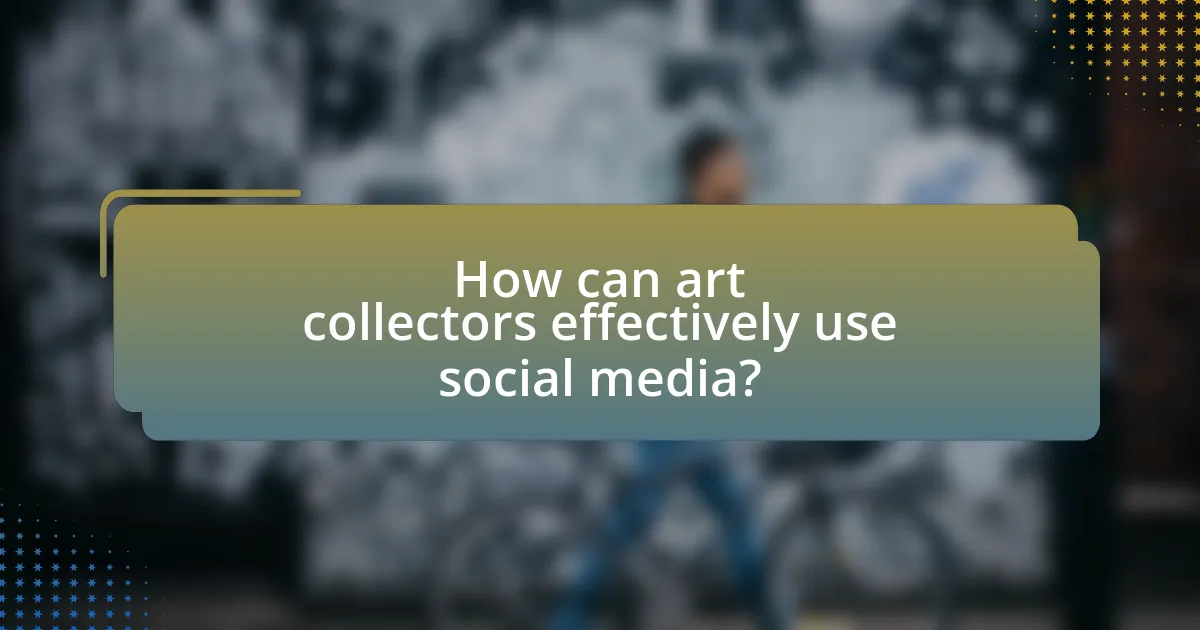
How can art collectors effectively use social media?
Art collectors can effectively use social media by showcasing their collections, engaging with artists and other collectors, and participating in online art communities. By posting high-quality images and stories about their artworks, collectors can attract attention and foster connections within the art world. Engaging with artists through comments and shares can lead to collaborations and insights into new trends. Additionally, joining platforms like Instagram and Facebook groups dedicated to art collecting allows collectors to exchange knowledge, discover new artists, and stay updated on market trends. Research indicates that 70% of art collectors use social media to discover new artists, highlighting its importance in the contemporary art landscape.
What strategies should collectors adopt for successful engagement on social media?
Collectors should adopt a strategy of consistent content sharing and community interaction for successful engagement on social media. By regularly posting high-quality images of their collections, sharing insights about the art pieces, and engaging with followers through comments and direct messages, collectors can build a loyal audience. Research indicates that brands that engage with their audience on social media see a 20-40% increase in customer loyalty. Additionally, utilizing relevant hashtags and participating in art-related discussions can enhance visibility and attract like-minded individuals, further fostering a sense of community.
How can collectors curate their social media feeds for art discovery?
Collectors can curate their social media feeds for art discovery by following specific strategies that enhance their exposure to diverse art forms and artists. They should actively follow art institutions, galleries, and artists to receive updates on new exhibitions and artworks. Engaging with art-related hashtags, such as #ArtCollector or #EmergingArtists, allows collectors to discover trending artworks and connect with the broader art community. Additionally, utilizing algorithms by liking and sharing posts related to their interests helps tailor their feeds to showcase relevant content. Research indicates that social media platforms significantly influence art market trends, with 70% of collectors using these platforms for art discovery, highlighting the effectiveness of these curation methods.
What are the best practices for showcasing a personal art collection online?
The best practices for showcasing a personal art collection online include high-quality photography, detailed descriptions, and effective use of social media platforms. High-quality photography captures the artwork’s details and colors accurately, enhancing viewer engagement. Detailed descriptions provide context, including the artist’s background, the artwork’s significance, and any relevant stories, which enrich the viewer’s understanding and appreciation. Effective use of social media platforms, such as Instagram and Pinterest, allows collectors to reach a broader audience, engage with art communities, and share their collection’s narrative, fostering connections with potential buyers and fellow enthusiasts. These practices are supported by studies indicating that visually appealing content and storytelling significantly increase audience interaction and interest in art collections.
What tools and resources are available for art collectors on social media?
Art collectors can utilize various tools and resources on social media, including dedicated platforms like Artsy and Saatchi Art, which facilitate the buying and selling of artwork. These platforms provide features such as artist profiles, curated collections, and auction capabilities, allowing collectors to discover new artists and artworks. Additionally, social media channels like Instagram and Pinterest serve as visual discovery tools, enabling collectors to follow artists, galleries, and trends in real-time. According to a 2021 report by Hiscox, 70% of art buyers use social media to discover new artists, highlighting its significance in the art collecting landscape.
Which apps and platforms enhance the art collecting experience?
Apps and platforms that enhance the art collecting experience include Artsy, Saatchi Art, and Instagram. Artsy provides a comprehensive marketplace for buying and selling art, featuring a vast database of artworks and artist profiles, which facilitates informed purchasing decisions. Saatchi Art offers a user-friendly platform for discovering and acquiring original artworks from around the world, supporting emerging artists and providing collectors with a diverse selection. Instagram serves as a powerful social media tool for artists and collectors alike, allowing users to showcase their collections, connect with artists, and discover new works through visual engagement. These platforms collectively improve accessibility, visibility, and community engagement in the art collecting process.
How can collectors leverage analytics to improve their social media presence?
Collectors can leverage analytics by utilizing data-driven insights to enhance their social media strategies. By analyzing engagement metrics such as likes, shares, comments, and follower growth, collectors can identify which types of content resonate most with their audience. For instance, a study by Sprout Social found that posts with images receive 650% more engagement than text-only posts, indicating that visual content is crucial for collectors to showcase their art effectively. Additionally, using tools like Google Analytics or social media insights allows collectors to track audience demographics and behavior, enabling them to tailor their content to specific segments. This targeted approach can lead to increased visibility and a stronger online presence in the art community.
What are the future trends of social media in art collecting?
Future trends of social media in art collecting include increased use of virtual reality (VR) and augmented reality (AR) for immersive art experiences, as well as the rise of blockchain technology for provenance tracking and ownership verification. Social media platforms are evolving to facilitate direct artist-to-collector interactions, enhancing community engagement and democratizing access to art. According to a report by Art Basel and UBS, 70% of collectors now use social media to discover new artists, indicating a shift towards digital platforms as primary sources for art acquisition. Additionally, the integration of e-commerce features on platforms like Instagram and Facebook is expected to streamline purchasing processes, making art more accessible to a broader audience.
How might emerging technologies influence social media’s role in art collecting?
Emerging technologies significantly enhance social media’s role in art collecting by facilitating greater accessibility and engagement for collectors. Technologies such as augmented reality (AR) and virtual reality (VR) allow potential buyers to visualize artworks in their own spaces, thereby increasing the likelihood of purchase. Additionally, blockchain technology provides a secure method for verifying the authenticity and provenance of art, which is crucial for collectors. According to a report by Art Basel and UBS, the online art market reached $6.8 billion in 2021, demonstrating the growing influence of digital platforms in art transactions. Furthermore, social media algorithms enable targeted marketing, connecting collectors with specific artists and artworks that align with their preferences, thus streamlining the collecting process.
What predictions can be made about the evolution of art collecting through social media?
The evolution of art collecting through social media is predicted to lead to increased accessibility and democratization of the art market. As platforms like Instagram and TikTok enable artists to showcase their work directly to a global audience, collectors will have greater opportunities to discover emerging talent outside traditional galleries. This shift is supported by data indicating that 70% of art collectors use social media to find new artists, highlighting the platform’s role in shaping purchasing decisions. Additionally, the rise of online art fairs and virtual exhibitions, accelerated by the COVID-19 pandemic, suggests that social media will continue to facilitate transactions and engagement, further transforming how art is collected and appreciated.










